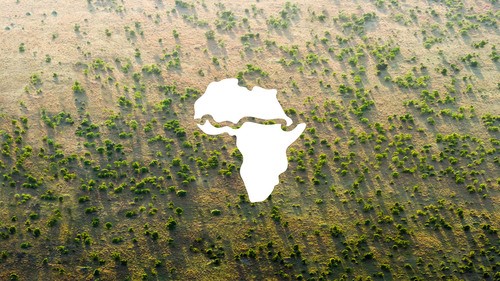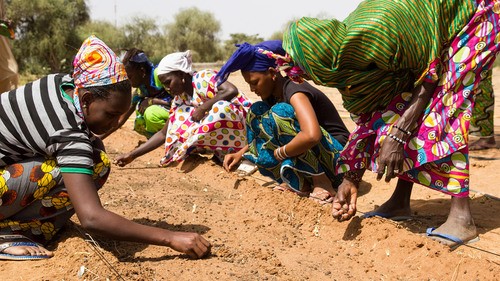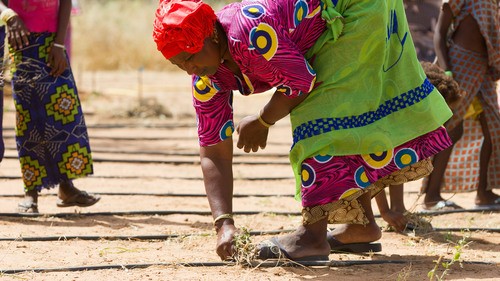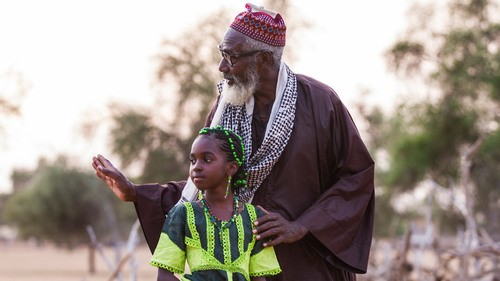The face of Africa’s Sahel, one of the most ecologically vulnerable areas in the world, is getting a makeover with a Great Green Wall of eucalyptus, cassava, and acacia trees. It is hoped that by 2030, the wall will restore 100 million hectares of currently degraded land, sequester 250 million tons of carbon, and create 10 million jobs in rural areas. Jared Scott’s film The Great Green Wall, takes us on a tour of the land and the people who are making this miracle happen. Judy Gelman-Myers, editor of Director Talk and its sister site Earth on Screen sat down to talk with Scott about the movie, the effect of climate change on the Sahel, and our shared responsibility to restore the natural balance of the world before it’s too late. Click here for the film’s website, trailer, and call to action.

JGM: Jared, what was your on-the-ground impression of the Great Green Wall?
JS: It’s in a fledgling stage, a burgeoning state. The ambition is to grow this wall of trees—which is really a metaphor—8,000 kilometers long and 15 kilometers wide, the entire width of the continent.
This is a massive ambition. My takeaway on the ground was this: here’s a devastated area, one of the most vulnerable to climate change, where they’ve done the least to contribute to the global problem. It’s a classic case of climate injustice, where those who do the least are going to get hit first and worst.
The temperature in the Sahel is rising about 1.5 times faster than the global average. It’s already a very vulnerable area. In fact, the word Sahel in Arabic means ‘shore.’ It’s a semidry, arid region. Below are the sands of the Sahara and above, more forested, humid areas. It’s a really fragile band already, where the conflict in Mali and Sudan have been raging for years. We’ve seen the Ethiopian famine, we’ve seen a lot of things take place in this area along the Sahel.
It’s a very fragile area. At the same time it’s a beautiful area. In the film we’re trying to balance the fragility with the beauty, the vulnerability with the vibrancy. That was really exciting. Being on the ground, I was trying to show a cautionary tale of unabated climate change and then the hope of a low-cost, nature-based solution. What gave me the most hope was not the technical aspects of growing trees but the people.

Planting seeds along the Great Green Wall
I live in New York and happen to make climate change films. An argument plays within me daily: pessimism vs. optimism, hope vs. despair, individual change vs. collective action. I’m constantly trying to figure out what can I do—what we can do—and I struggle with that. Sometimes you throw up your hands and want to walk away. Other times you want to roll up your sleeves and get to work.
What I noticed on the ground on the front lines of the Great Green Wall is that there is so much determination, optimism, and resolve. People there are basically at ground zero for desertification and climate change, as well as all the consequences that come with land degradation: conflict, mass migration, resource scarcity, you name it. I was surprised by the level of optimism they all have, the determination. What I recognized is that the pessimism or indifference that happens in the U.S. is a bit of a luxury. If you’re faced with this every day, like the people in the Sahel, you have to do something about it or feel hopeful about doing something about it. When you worry about not what’s going to happen next year or in ten years but what’s going to happen tomorrow, that sense of immediacy of the problem is much more in the foreground. I was constantly amazed by the people I met and how positive and determined they were. That was really exciting.
This project of the Great Green Wall is really in its nascent stages. It’s a big, ambitious idea, but I think that’s the beauty of it. Look at the 2 degrees warming that we’ve determined to be the red line, politically, for global climate change. Best-case scenario, if we stopped using fossil fuels tomorrow, we might be able to meet that goal. In reality, we have a slim to none chance of hitting that mark. That doesn’t mean we move the goalposts. It doesn’t mean we say, “It’s okay if it’s 3 degrees warming,” or if we’re on track for 6 degrees warming, we have to just accept it. No, as Confucius said, you don’t change the goals, you change the action that gets you there. It’s the same thing with this.
This is a giant ambition; the likelihood that this will be done in our lifetime, let alone by the ambitious target of 2030, is far off. But what would be the alternative? To just say, “Hey, we’ll just try to create a little buffer for the worst crisis we’ve ever faced as a global community?” That’s not inspiring, right? This idea, this visual idea to grow this wall of trees, is really exciting.
If you break it down, it’s actually a mosaic of regreening projects. And development begets development. If they get this right, they get a lot of other things right. The Great Green Wall could be a litmus test for so many other development measures. The UN has set 17 Sustainable Development Goals. The Great Green Wall touches upon 15 of them. It’s a holistic process, it’s not just about putting a tree in the ground. It’s about improving livelihoods, job security, human security. It’s about creating and revitalizing ecosystems and communities. It’s a holistic approach.
The project in Ethiopia is different from the project in Senegal. The private projects are different from the farmer-led projects. It’s going to have to be an all-the-above approach. And this idea can’t happen in a vacuum. You have to look at deforestation, you have to look at our continuing dependence on fossil fuels. This has to be one of many solutions as we try to improve our world. And it has to be a narrative of an African dream that manifests in the form of this green wall that gives hope to a continent that is at a crossroads right now.

Inna Modja
JGM: Inna Modja, the Malian actress and singer who serves as the film’s guide, speaks very eloquently about creating an African dream. What is the African dream in her eyes? I imagine it’s quite different from the American dream.
JS: I don’t want to speak for Inna, but what I recognized on the ground is that Inna and the Sahelian Africans we spoke with see the African dream as more of a communal dream. I think the American Dream is not a rags-to-riches dream but the Horatio Alger “I can pull myself up by my own bootstraps, and if I work hard enough, social mobility and prosperity are within my grasp,” right? Usually that applies to your immediate family as well.
The African dream is a communal dream. Maslow’s hierarchy of needs is still there. Everyone wants self-actualization, everyone needs food, shelter, clothing. The migrants in the desert heading north wanted to improve their self-actualization, they want to have, as one person put it, distinction, noblesse in French. At the same time they’re doing it because they feel that as the oldest person in their family, it’s their job to change the poverty, it’s their job to take care of family. And if you take care of the family, you have to move on to your extended family. If you take care of your extended family, you have to move on to the village. To take care of the village, you have to take care of the town. To take care of the town, you have to take care of the state. Basically it never stops. And that’s what’s interesting—this idea of communally putting their hopes and faith in certain people, an expectation that they have to bring prosperity to the community at large. There was an individual drive, but it felt communal, more so than the American dream.
That communal aspect fits perfectly with the idea of the wall. You don’t try to revitalize an ecosystem for yourself. It’s a communal thing. The Tragedy of the Commons incentivizes people to act in their own self-interest. The Great Green Wall tries to reverse that. The idea is to act on behalf of the community, on behalf of the greater good, from the village all the way up to this bigger idea of pan-Africanism as elucidated by Thomas Sankara [president of Burkina Faso from 1983 to 1987] so well in the film.
JGM: On the ground, how did the Great Green Wall vary from country to country, and how does that intersect with pan-Africanism?
JS: The idea of pan-Africanism is this idea of unity, and the idea of The Great Green Wall at its core is about unity. In a world of walls, we often think of their divisive nature. At the time the Berlin Wall was constructed, there was a handful of walls. Now I think there are 70 walls around the world. It seems like we’re building more walls to keep people divided.
The Great Green Wall is a wall that unites, like pan-Africanism. It’s a different type of wall, which delivers a strong message saying: “Let’s unite behind a common cause.” In a continent holding 54 countries and one self-governing territory, Pan-Africanism tries to band nations together.
That idea of unity is also really important across the globe. Climate change is our first major global problem, save thermonuclear war, and the first problem that’s going to take global action. The Wall started out with 11 countries, and then became 13. And now there are over 20 countries that have Great Green Wall initiatives across the continent.
Other places have similar projects. There’s one in China; there’s one happening in South America. There are now tons of people pledging to plant a trillion trees. There’s a nature conservancy. There are so many amazing projects. This idea of regreening, this low-cost solution to the problem, obviously can’t be the only thing we do, but as part of that silver buckshot we need to solve the climate crisis. I think it’s a hopeful story. You can see the action taking place. I think that hopeful narrative is important to the global community, and it’s important to the pan-African dream as well.

Local customs and knowledge dictate what is planted where.
JGM: I imagine national variations in the Green Great Wall are based not only on local custom and farming traditions but also on the degree of militarization and local politics.
JS: We started in Senegal because we wanted to travel west to east, and Senegal was the first country to adopt a modern Great Green Wall initiative. There have been conversations about regreening the desert since the ’50s. There was a green belt in Kenya that took shape in the ’70s, as well as the Algerian green dam. There was a green belt around Niger. There have been a lot of projects inspired by Thomas Sankara, who planted about 10 million trees and had a “One Village, One Grove” policy, where he was trying to eliminate food insecurity and foster independence by reducing dependence on colonial imports.
As you said, it varies from country to country. In Senegal, where they’re trying to plant things that are drought resistant, there’s the acacia Senegal tree [Senegalia senegal], which is quite common. In Ethiopia, which is at a higher altitude, they’re planting eucalyptus. Their rainfall variability is more normalized, as opposed to everything being barren. In Niger there’s farmer-managed natural regeneration, FMNR, which relies not on planting trees but on growing trees. The difference is you rely on the seed memory of the soil. You revitalize things that are already in there, catch the water, add manure, and start to have growth.
That all relies on local farming knowledge, right? You can’t just come into a country and start planting. You have to talk to the people, work with those who know their customs. That worked really well in the south of Niger.
People rely on rain-fed agriculture across the Sahel. I think less than 5 percent is irrigated, and most, if not all, is directly next to a body of water. In California, where the fruits and nuts of the world come from, water is pumped in. That doesn’t happen in the Sahel. They rely on rain-fed agriculture, so you have to consider whether a plant species is drought resistant, whether there/s going to be farmers or herders there. It’s difficult, no doubt about it.
There’s a reason why this is 10 to 15 percent underway. Underway is an interesting word. There’s never been third party analysis of the progress. I think it’s getting better with some AI technology and satellite mapping, but underway can mean that things have been planted, maybe some space has been earmarked, maybe something started and then regressed. So you can get confused with the idea that 15 percent is underway. It’s going to be a mosaic of different things, from planting trees to harvesting baobab, to revitalizing the ecosystem in Ethiopia to FMNR in Niger, from regeneration to private companies doing agroforestry. A number of things will make up this patchwork initiative to create the overall mosaic of the Great Green Wall.
JGM: As I was watching the film, I kept wondering how people are going to make a desert green. Can you address that disconnect?
JS: 80 to 90 percent of the population is living on some form of agriculture, doing rain-fed subsistence farming. Rain is everything. The Sahel has always been a volatile place. We know that with climate change, rainfall variability is getting more erratic. A lot of these places usually have no rain, or then all of a sudden, a lot of rain. That’s a general feature of climate change writ large—it’s either too little, or all of a sudden there’s way too much. And there is a rainy season in the Sahel.
In the film, a farmer in Senegal says, “We only have one month to plant. We have to plant when it’s raining, and it only rains between August and September. We have to rely on that.” They’re working with indigenous species that have thrived in these areas before, and they’re reforesting, or regrowing, or regreening areas that have been degraded, often by mismanaged farming practices like overgrazing and resulting soil erosion. There’s history there. There’s a difference between that and coming in and trying to grow stuff in places that never had those plants.
That’s the one misnomer to watch out for. I haven’t seen any places that were just desert and all of a sudden they go planting stuff and it works out. They’re trying to regain places that have a history, that have been degraded over years and that are continuing to be degraded. They’re trying to revitalize this land, as opposed to just going to a patch of desert and planting some kind of oasis. It’s going to be tricky, because in a lot of places, there isn’t a lot growing or a lot of people who have historically grown there. There’s a reason why there are a lot of nomadic Fulani, namely herders, in the north, because traditionally the climate created a more migratory cultural experience, where people have animals and travel. You go to the south of Senegal, and it’s quite lush. A lot of things grow down there. Up north, not so much. So different vegetation is going to work in different places. If you think of the wall more broadly, you have to consider different parts of the challenge to achieve those goals.
Going back to your question about politics and militarization, if you’re trying to revitalize in Mali, where you have ongoing conflict and instability, people have much more immediate problems than going out and trying to regreen an area. Also, aid has a hard time getting in. This element doesn’t thrive when there’s conflict. It’s the complete opposite. But every dollar of development going to preventative measures is worth its weight in gold, because as soon as something goes wrong, you have to spend so much money to even get the political support to go there and try to solve it. One of the challenges with the Great Green Wall is to think ahead and revitalize these areas before they become much worse. We already know that about 65 to 70 percent of the land is considered to be extremely degraded, according to the FAO, so we’re not in a great spot. We’re trying to do everything we can.
JGM: You spoke about degradation from farming practices. But isn’t there a connection between climate change and desertification in the Sahel?
JS: Climate change is a threat multiplier. It exacerbates everything. You already have areas that were very dry and very hot. At the dawn of the Industrial Revolution it was still a very volatile region. Take climate change and you’re throwing gasoline on the fire, right? Climate change has made everything worse. It’s affecting rainfall variability, which is key for agriculture. The more erratic it is, the harder it is for people. If you already had a very drought-prone region, now climate change is making drought more extreme, and the droughts are lasting longer. That’s a problem. If you already have desertification, and all of a sudden the climate makes the temperatures rise faster, that adds to more burnout. So climate change just makes everything worse.

Listening to an elder who knows what species used to grow here
People talk about older times when the droughts weren’t as long or things were a little more verdant. The elders have seen it change. The newer groups haven’t seen that, so we have to rely on our elders to say, “You know, it wasn’t always like this. At one point there was this species here, we had cotton off the coast of Spain there. Things were different.” That story seems to ring true from elders across the Sahel.
JGM: Both you and Inna use art to promote climate action. Can you talk briefly about the intersection between art and politics?
JS: No matter what you do or who you are, we all have to use our passions and our talents to tell stories or raise awareness or take action. I happen to make films, so I use films as tools to try to engage people on this issue and try to make it entertaining. If you’re a musician like Inna, same story: You’re trying to get people’s attention to bring them in without making it feel too didactic or pedantic. It has to be entertaining. We have to engage people, because we’re all so desensitized.
Everyone has a role to play. If you’re a journalist, write about it. If you’re an accountant, there are plenty of NGOs that need your help. If you’re a dancer or an artist, great. If you’re a lawyer, someone needs a good lawyer. Whatever you’re doing, I think we all have a role to play. We all have to fight this battle individually.
We also need greater collective action. We need political action, we need to force political will. It’s everything. I’ve done a number of climate films, and I’m always trying to find a way to not preach to the choir, to try to keep telling the story differently. You covered my film The Age of Consequences. In that film we looked at national security to try to wake up people on the right. We wanted to give folks a way to talk to Uncle Bob at Thanksgiving in a different way. Instead of “We’ve got to take to the street” it was “Military institutions are looking at climate change.”
With The Great Green Wall, it’s important to see this as a personal story. We wanted to humanize the problem and not make it so climate driven. There’s no smokestack in this film. There’s no solar panel. There’s no science in this film. It’s just, Hey, the people telling this story happen to be living in a place that’s now been forever touched by our changing climate. That’s their narrative now, and here’s this story that we wanted to tell.
We also wanted the audience to experience this social club style of using music. Inna had to channel all of this when she was there, and it was cathartic for her to have a place to put this experience. She’s not a reporter, she’s not an expert; she’s an artist, musician, activist. Now she’s a UNCCD Land Ambassador, which happened after the film.
The idea is to connect with people and also raise money with the music. That’s one of the goals as well, to use the album to raise money. I think we have a responsibility as artists, or as people who have a platform, to find creative ways to keep telling the story lest we all become desensitized…
This is an age of distraction, so the goal is to tell a good story, break through the saturation, break through the distraction, and hopefully reawaken the ability to change the world that we all have within us.